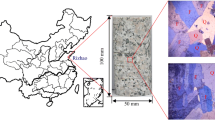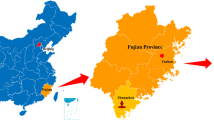Abstract
The effects of thermal treatment on the pore structure and mechanical property evolution of granite were experimentally investigated to evaluate the risks of traditional and critical geothermal systems. The microstructure of thermally treated granite was studied using an optical microscope and nuclear magnetic resonance, and the mechanical properties of thermally treated granite were studied under uniaxial compression. X-ray diffraction results showed that the mineralogical phase of granite hardly changed during thermal treatment from room temperature to 800 °C, but the granite experienced first a decrease and then an increase in porosity. Although overall porosity decreased at 200 °C, the proportion of pore throat radium beyond 6.3 μm grew increasingly with the treatment temperature, facilitating advective heat transport in the geothermal system. Intergranular microcracks caused by thermal anisotropic properties started at below 400 °C, and transgranular microcracks first appeared in feldspar at around 400 °C, finally extending to quartz at around 600 °C. The granite was strengthened due to decreased porosity at around 200 °C. Then, the granite was weakened and the failure transited from brittle to ductile due to increased porosity, where a sharp reduction occurred at 400–600 °C for α-β transition of quartz. The change in strength by cyclic heating under 200 °C was unnoticeable for temperature memory effect, but the cumulative strain at peak stress increased with the number of heating cycles. The changes in the pore and mechanical properties caused by thermal treatment favour geothermal systems which are not within the tectonic zone. However, increased porosity and strength weakening destabilize nearby faults due to normal stress release and strength weakening.















Similar content being viewed by others
References
Becattini V, Motmans T, Zappone A, Madonna C, Haselbacher A, Steinfeld A (2017) Experimental investigation of the thermal and mechanical stability of rocks for high-temperature thermal-energy storage. Appl Energy 203:373–389
Brotóns V, Tomás R, Ivorra S, Alarcón JC (2013) Temperature influence on the physical and mechanical properties of a porous rock: San Julian’s calcarenite. Eng Geol 167:117–127
Chaki S, Takarli M, Agbodjan WP (2008) Influence of thermal damage on physical properties of a granite rock: porosity, permeability and ultrasonic wave evolutions. Constr Build Mater 22(7):1456–1461
Chen SW, Yang CH, Wang GB (2017a) Evolution of thermal damage and permeability of Beishan granite. Appl Therm Eng 110:1533–1542
Chen YL, Wang SR, Ni J, Azzam R, Fernández-Steeger TM (2017b) An experimental study of the mechanical properties of granite after high temperature exposure based on mineral characteristics. Eng Geol 220:234–242
Cooper HW, Simmons G (1977) The effect of cracks on the thermal expansion of rocks. Earth Planet Sci Lett 36(3):404–412
Ding QL, Ju F, Mao XB, Ma D, Yu BY, Song SB (2016) Experimental investigation of the mechanical behavior in unloading conditions of sandstone after high-temperature treatment. Rock Mech Rock Eng 49(7):2641–2653
Faulkner DR (2010) Slippery when wet? Nat Geosci 3:449–450
Fei Y (1995) Thermal expansion. In: Ahrens TJ (ed) Mineral Physics Crystallography: A Handbook of Physical Constants, vol 2, 1st edn. American Geophysical Union, Washington, D.C., pp 29–44
Forster A, Forster HJ, Krentz O (2018) Exploration of the enhanced geothermal system (EGS) potential of crystalline rocks for district heating (Elbe Zone, Saxony, Germany). Int J Earth Sci 107(1):89–101
Gautam PK, Verma AK, Jha MK, Sarkar K, Singh TN, Bajpai RK (2016a) Study of strain rate and thermal damage of Dholpur Sandstone at elevated temperature. Rock Mech Rock Eng 49(9):3805–3815
Gautam PK, Verma AK, Maheshwar S, Singh TN (2016b) Thermomechanical analysis of different types of sandstone at elevated temperature. Rock Mech Rock Eng 49(5):1985–1993
Giardini D (2009) Geothermal quake risks must be faced. Nature 462(7275):848–849
Glover PWJ, Baud P, Darot M, Meredith PG, Boon SA, Leravalec M, Zoussi S, Reuschle T (1995) Alpha/beta phase-transition in quartz monitored using acoustic emissions. Geophys J Int 120(3):775–782
González-Gómez WS, Quintana P, May-Pat A, Avilés F, May-Crespo J, Alvarado-Gil JJ (2015) Thermal effects on the physical properties of limestones from the Yucatan Peninsula. Int J Rock Mech Min Sci 75:182–189
Hajiabdolmajid V, Kaiser P (2003) Brittleness of rock and stability assessment in hard rock tunneling. Tunn Undergr Space Technol 18(1):35–48
Hajpál M, Török Á (2004) Mineralogical and colour changes of quartz sandstones by heat. Environ Geol 46(3):311–322
Hanley EJ, Dewitt DP, Roy RF (1978) The thermal diffusivity of eight well-characterized rocks for the temperature range 300–1000 K. Eng Geol 12:31–47
Hawkes I, Mellor M (1970) Uniaxial testing in rock mechanics laboratories. Eng Geol 4(3):177–285
He L, Yin Q, Jing H (2018) Laboratory investigation of granite permeability after high-temperature exposure. Processes 6(4)
Homand-Etienne F, Troalen JP (1984) Behaviour of granites and limestones subjected to slow and homogeneous temperature changes. Eng Geol 20(3):219–233
Kranz RL (1983) Microcracks in rocks: a review. Tectonophysics 100(1):449–480
Kumari WGP, Ranjith PG, Perera MSA, Chen BK, Abdulagatov IM (2017a) Temperature-dependent mechanical behaviour of Australian Strathbogie granite with different cooling treatments. Eng Geol 229:31–44
Kumari WGP, Ranjith PG, Perera MSA, Shao S, Chen BK, Lashin A, Arifi NA, Rathnaweera TD (2017b) Mechanical behaviour of Australian Strathbogie granite under in-situ stress and temperature conditions: an application to geothermal energy extraction. Geothermics 65:44–59
Lala AMS, El-Sayed NAA (2017) Controls of pore throat radius distribution on permeability. J Pet Sci Eng 157:941–950
Lin WR (2002) Permanent strain of thermal expansion and thermally induced microcracking in Inada granite. J Geophys Res Solid Earth 107(B10)
Liu S, Xu J (2015) An experimental study on the physico-mechanical properties of two post-high-temperature rocks. Eng Geol 185:63–70
Mahmutoglu Y (1998) Mechanical behaviour of cyclically heated fine grained rock. Rock Mech Rock Eng 31(3):169–179
Parisio F, Vilarrasa V, Wang W, Kolditz O, Nagel T (2019) The risks of long-term re-injection in supercritical geothermal systems. Nat Commun 10:4391
Ranjith PG, Viete DR, Chen BJ, Perera MSA (2012) Transformation plasticity and the effect of temperature on the mechanical behaviour of Hawkesbury sandstone at atmospheric pressure. Eng Geol 151(Supplement C):120–127
Richter D, Simmons G (1974) Thermal expansion behavior of igneous rocks. Int J Rock Mech Min Sci Geomech Abstracts 11(10):403–411
Shao S, Ranjith PG, Wasantha PLP, Chen BK (2015) Experimental and numerical studies on the mechanical behaviour of Australian Strathbogie granite at high temperatures: an application to geothermal energy. Geothermics 54:96–108
Siegesmund S, Sousa L, Knell C (2018) Thermal expansion of granitoids. Environ Earth Sci 77(2):41
Simmons G, Richter D (1976) Microcracks in rock. In: Strens RGJ (ed) The Physics and Chemistry of Minerals and Rocks, vol 27, 1st edn. Wiley, New York, pp 105–137
Thirumalai K, Demou SG (1974) Thermal expansion behavior of intact and thermally fractured mine rocks. AIP Conference Proceedings 17(1):60–71
Tian H, Ziegler M, Kempka T (2014) Physical and mechanical behavior of claystone exposed to temperatures up to 1000°C. Int J Rock Mech Min Sci 70:144–153
Tiskatine R, Eddemani A, Gourdo L, Abnay B, Ihlal A, Aharoune A, Bouirden L (2016) Experimental evaluation of thermo-mechanical performances of candidate rocks for use in high temperature thermal storage. Appl Energy 171:243–255
Tomac I, Sauter M (2018) A review on challenges in the assessment of geomechanical rock performance for deep geothermal reservoir development. Renew Sust Energ Rev 82:3972–3980
Ulusay R (2015) The ISRM Suggested Methods for Rock Characterization, Testing and Monitoring: 2007-2014, 1st edn, New York, Springer
Van Der Molen I (1981) The shift of the α-β transition temperature of quartz associated with the thermal expansion of granite at high pressure. Tectonophysics 73(4):323–342
Villarraga CJ, Gasc-Barbier M, Vaunat J, Darrozes J (2018) The effect of thermal cycles on limestone mechanical degradation. Int J Rock Mech Min Sci 109:115–123
Violay M, Gibert B, Mainprice D, Evans B, Dautria JM, Azais P, Pezard P (2012) An experimental study of the brittle-ductile transition of basalt at oceanic crust pressure and temperature conditions. J Geophys Res Solid Earth 117:B03213
Weng W, Wu ZJ, Liu QS (2020) Influence of heating/cooling cycles on the micro/macrocracking characteristics of Rucheng granite under unconfined compression. Bull Eng Geol Environ 79(3):1289–1309
Xu XL, Gao F, Shen XM, Xie HP (2008) Mechanical characteristics and microcosmic mechanisms of granite under temperature loads. J China Univ Min Technol 18(3):413–417
Yang SQ, Ranjith PG, Jing HW, Tian WL, Ju Y (2017) An experimental investigation on thermal damage and failure mechanical behavior of granite after exposure to different high temperature treatments. Geothermics 65:180–197
Yang SQ, Huang YH, Tian WL, Yin PF, Jing HW (2019) Effect of high temperature on deformation failure behavior of granite specimen containing a single fissure under uniaxial compression. Rock Mech Rock Eng 52:2087–2107
Yao M, Rong G, Zhou C, Peng J (2016) Effects of thermal damage and confining pressure on the mechanical properties of coarse marble. Rock Mech Rock Eng 49(6):2043–2054
Yong C, Wang CY (1980) Thermally induced acoustic emission in westerly granite. Geophys Res Lett 7(12):1089–1092
Zhang W, Sun Q, Zhu S, Wang B (2017) Experimental study on mechanical and porous characteristics of limestone affected by high temperature. Appl Therm Eng 110:356–362
Zhu J, Hu K, Lu X, Huang X, Liu K, Wu X (2015) A review of geothermal energy resources, development, and applications in China: current status and prospects. Energy 93:466–483
Funding
This study was financially supported by the National Natural Science Foundation of China (Grant Nos. 5181101971 and 51674047), the National Science Fund for Distinguished Young Scholars (Grant No. 51625401) and the 2019 Endeavour Australia Cheung Kong Research Leadership Award.
Author information
Authors and Affiliations
Corresponding author
Rights and permissions
About this article
Cite this article
Zhang, Z., Ma, B., Ranjith, P.G. et al. Indications of risks in geothermal systems caused by changes in pore structure and mechanical properties of granite: an experimental study. Bull Eng Geol Environ 79, 5399–5414 (2020). https://doi.org/10.1007/s10064-020-01901-z
Received:
Accepted:
Published:
Issue Date:
DOI: https://doi.org/10.1007/s10064-020-01901-z




